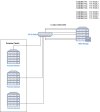Hi,
We have installed a new storage HPE MSA 2060. the storage server has two controllers A&B and each controller has 4 nics(8 nics in total). and each NIC is configured with an IP. so the two controllers have 8 IPs in total.
We're are trying to connect a proxmox cluster to the storage. but not sure which IP of the storage's 8 IPs should we use.
Proxmox allows us to only add 1 ip for the portal. we can't use just one IP becasue we need to have redundancy.
I have attached a diagram detailing the setup.
Let me know if you have any questions.
We have installed a new storage HPE MSA 2060. the storage server has two controllers A&B and each controller has 4 nics(8 nics in total). and each NIC is configured with an IP. so the two controllers have 8 IPs in total.
We're are trying to connect a proxmox cluster to the storage. but not sure which IP of the storage's 8 IPs should we use.
Proxmox allows us to only add 1 ip for the portal. we can't use just one IP becasue we need to have redundancy.
I have attached a diagram detailing the setup.
Let me know if you have any questions.


